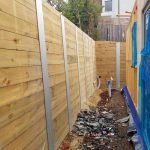Introduction
In the lively and frequently unpredictable environment of Melbourne, many property owners find themselves facing the challenges of uneven terrain and soil disintegration. This is where retaining walls enter into play. Not just do they serve a useful purpose by avoiding soil erosion, however they likewise improve the visual appeal of your residential or commercial property. But how does one tackle installing a retaining wall? In this detailed guide, we will explore The Step-by-Step Process of Effective Retaining Wall Setup in Melbourne, exploring whatever from initial preparation to last touches.
Understanding Keeping Walls
What Are Keeping Walls?
Retaining walls are structures developed to hold back soil and rock from abnormal slopes. They can be made from various products such as wood, concrete, brick, or stone. The main function is to avoid soil erosion and to produce flat areas for landscaping or building.
Why Do You Need a Keeping Wall?
There are many reasons that somebody may consider setting up a retaining wall:

- Prevent Soil Erosion Create Usable Land Space Improve Visual Appeal Increase Residential or commercial property Value
Types of Retaining Walls
When it concerns picking a retaining wall type, you'll normally come across:
Timber Sleeper Retaining Wall Concrete Sleeper Retaining Wall Brick Keeping Wall Stone Keeping WallEach has its special advantages and viability based on your specific needs.
The Step-by-Step Process of Effective Retaining Wall Setup in Melbourne
Step 1: Initial Planning and Design
Before you even think http://cashvstt393.trexgame.net/from-principle-to-conclusion-a-day-in-the-life-of-a-retaining-wall-builder of getting a shovel, you need to plan.
Assessing Your Site
Begin by examining your website's topography and drain patterns. Keep an eye out for potential problems that might affect your installation process later on on.
Design Considerations
Consider elements like height, materials, and function. Will it be simply practical or do you desire it to improve your landscape?
Step 2: Working with an Expert Contractor
Choosing the Right Retaining Wall Contractor Melbourne
Hiring a skilled retaining wall specialist can conserve you time and disappointment. You'll desire somebody who understands regional regulations, comprehends soil key ins Melbourne, and has experience with different materials.
Questions to Ask Your Contractor
- What is your experience with retaining wall installation? Can you supply recommendations or examples of previous work? What warranties do you offer?
Step 3: Getting Necessary Permits
Before beginning any construction work in Melbourne, check if you need a license. Local regulations can vary significantly based upon where you live.
Materials for Your New Retaining Wall
Timber Sleeper Retaining Walls
Timber walls are aesthetically attractive but might need more maintenance gradually due to rot or insect damage.
Benefits:
- Cost-effective Easy to install
Concrete Sleeper Retaining Walls
These walls use toughness and low maintenance requirements.
Benefits:
- Long lifespan Resistant to rot
Brick Keeping Walls
Bricks provide a classic appearance that matches numerous landscaping styles.
Benefits:
- Aesthetically pleasing Strong structure
Stone Keeping Walls
Natural stone uses unequaled beauty however can be labor-intensive throughout installation.
Benefits:
- Unique appearance Highly durable
The Setup Process Explained in Detail
Step 4: Preparing the Site for Installation
Once you've selected the ideal materials and secured permits, it's time to prepare the site.
Clearing the Area
Remove any plants or debris from the location where the wall will be built.
Digging Trenches
You will require to dig trenches deep enough to accommodate your chosen products while making sure proper drainage behind the wall.
Step 5: Building Your Foundation
A solid structure is crucial for any retaining wall's longevity.
Installing Gravel Base
Lay down gravel at the bottom of your trench for drainage purposes-- this step helps in reducing hydrostatic pressure behind the wall.
Constructing Your Retaining Wall Structure
Step 6: Laying First Course of Blocks or Timbers
Start laying your first course level with mindful attention paid to positioning and levelness using a string line or laser level.
Step 7: Including Additional Courses
Continue adding courses according to your style plan while guaranteeing that each course is staggered for strength.
Finishing Touches on Your New Wall
Step 8: Backfilling Behind the Wall
Once set up, backfill with gravel or soil while taking care not to interrupt your newly placed blocks or timbers.
FAQs about Maintaining Walls
li20/ol2/li21li21/ol3li22# The length of time does it require to install a retaining wall?- Typically, setup can take in between one day to two weeks depending on size and complexity.
- Generally under one meter; consult local laws for specifics.
- Yes! Proper drain prevents water accumulation which might result in failure over time.
Conclusion
Installing a retaining wall is no small task-- it requires mindful planning, execution, and expertise. By comprehending each action described in this guide about The Step-by-Step Process of Effective Retaining Wall Setup in Melbourne, you'll be well-equipped to tackle this task whether you're considering working with a retaining wall contractor or starting a do it yourself adventure. In either case, investing time upfront will settle by creating a long-lasting structure that improves both functionality and visual appeals on your property!